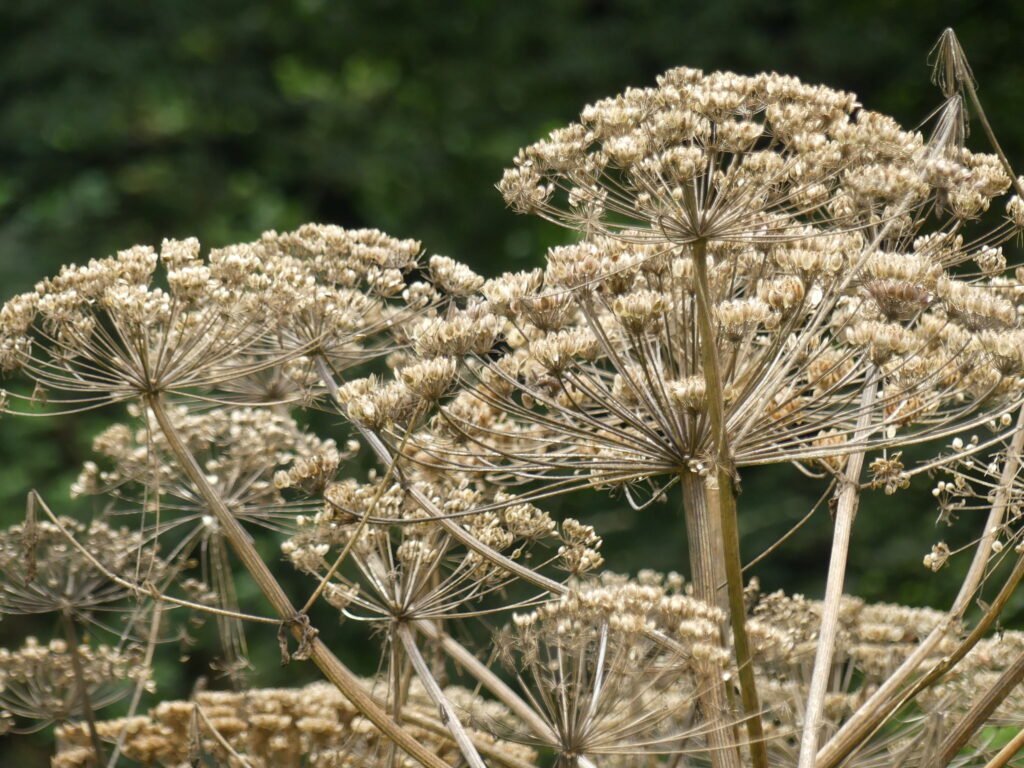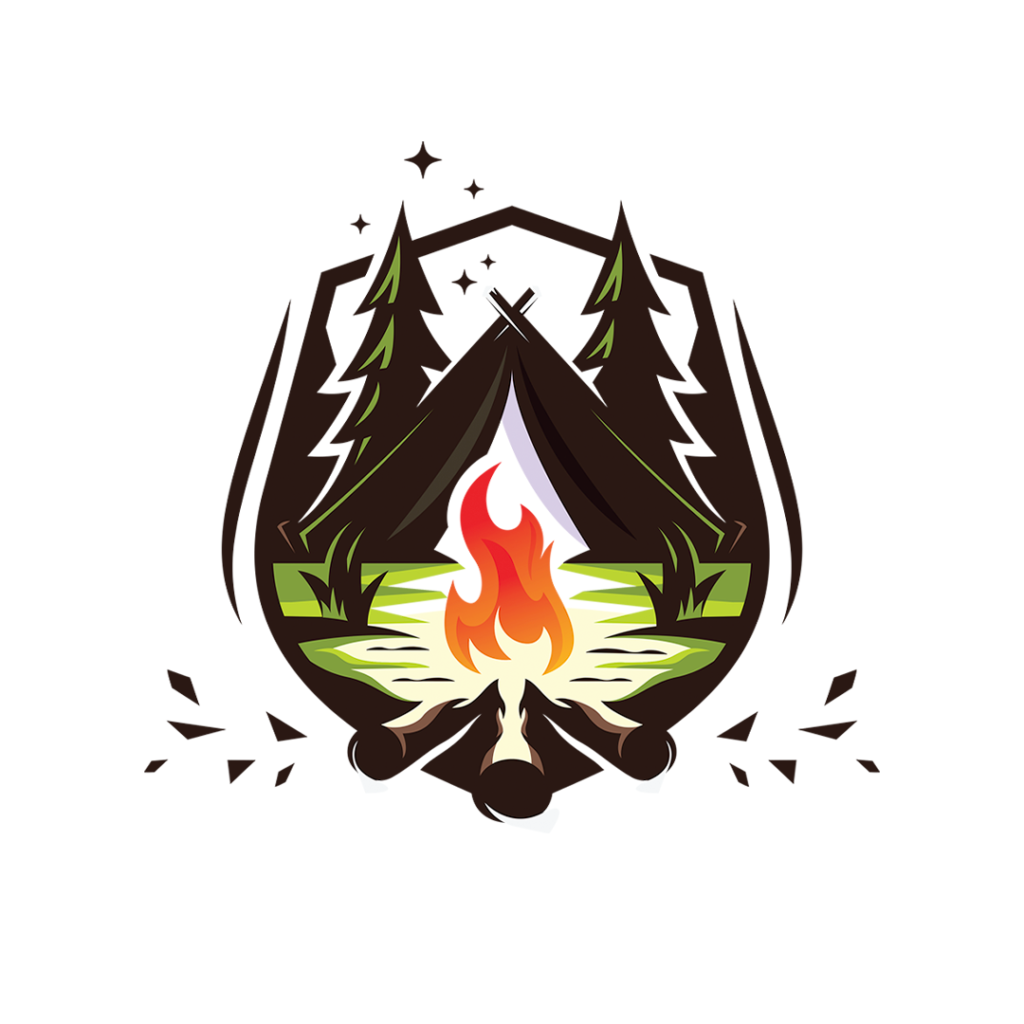Ah! Plants. Remember when there was a time when the most significant threat a flower posed to our young, naive brains was the thorns on roses? The reality is a lot scarier. In fact, it’s the inspiration behind the morbid UK Dark Tourism site, The Garden of Death, which covers countless toxic plants.
Plants are the world’s most successful organisms and cover every square inch of the planet in some way, shape, or form. Of course, some are beautiful, some even strange. Regardless of their orientation, they all serve a purpose in their environment! Unfortunately, though, as much as we get told to “stop and sniff the roses,” when it comes to camping, we’d advise against it!
Toxic plants can be found everywhere and pose an unsuspecting threat if you don’t know how to identify them. As a result, we’re bringing you a guide to navigating some toxic plants you’ll come across in North America in this helpful Camping Survival Guide. So, let’s get started!
Understanding Toxic Plants
Let’s face it: not everyone is a botanist at heart, and most people can name and recognize only a handful of the plants and flowers they see. As a result, we’re constantly at risk of falling prey to some dangerous flower or plant. It’s not a crazy thought, considering the American wilderness is loaded with innocent-looking toxic plants.
In nature’s grand design, toxic plants serve a rather intriguing purpose: self-preservation. They’re here to thrive and survive and don’t care much who they take down in the process! These green warriors have evolved to produce toxic compounds that act as a formidable defense mechanism.
Why? Well, some plants are just built differently! Surprisingly, a plant that might be toxic to us won’t necessarily be harmful to a bird or deer. On the other hand, some of these plants won’t hesitate to take us down. It’s all part of the strange natural balance.
Identifying Toxic Plants
So the next question is, how do you identify which plants are toxic and which aren’t? We wish we could give you a fully inclusive guide on that. But there are thousands of toxic plants out there. We don’t have the resources, and frankly, you don’t want to spend the next ten years learning about plants from a single post! Consequently, we’re not going to be able to cover everything. Instead, we’ve come up with a compromise, though.
Instead of going over every single plant we can find, we just thought we’d sum up North America’s most common!As a result, you’ll be more prepared for the potential dangers that exist near your prospective campsite.
8 Common Toxic Plants of North America
Let’s take a look at the eight common toxic plants you are likely to encounter in North America.
Poison Ivy
Toxicodendron radicans
Poison Ivy is a deceptive plant that often lurks in wooded areas, blending seamlessly with its surroundings. At some point or another, you or someone you know would have had a nasty encounter with Poison Ivy. While it can cause an insane amount of discomfort, the plant is not known for being deadly.
Poison Ivy is best identified with one simple phrase: “Leaves of three, let it be!” This refers to the distinctive three almond-shaped leaf clusters that make up the plant.
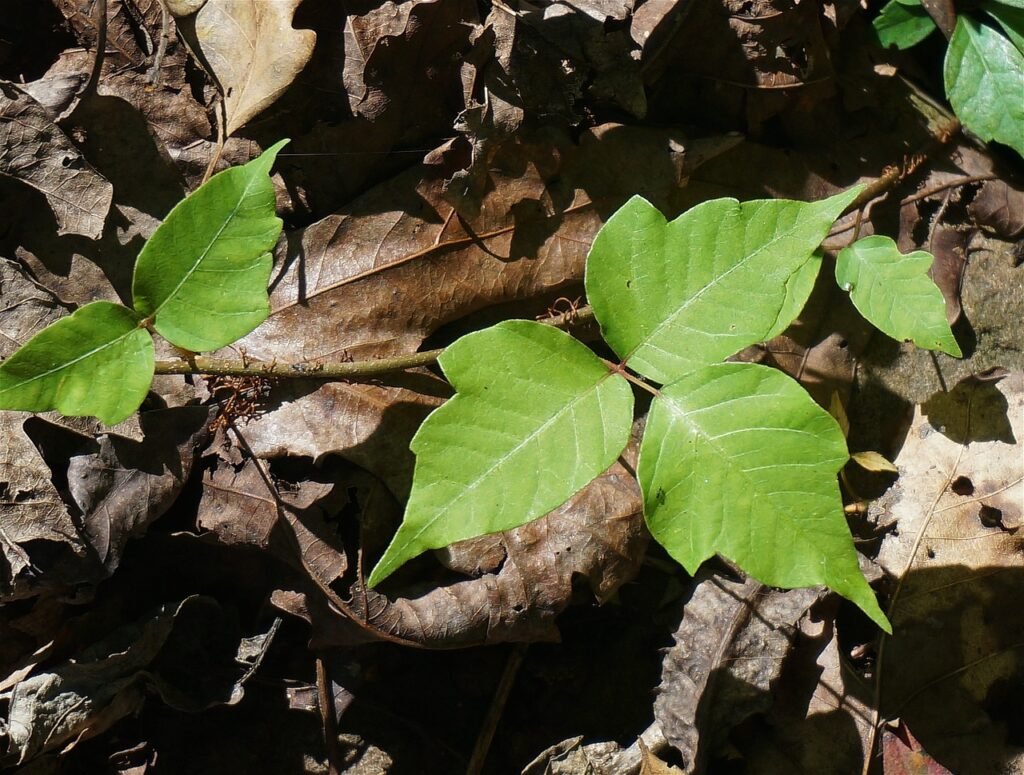
These leaves can display slightly serrated edges but can come in smooth variations.
The plant contains a poisonous oil called urushiol that causes gnarly allergic reactions. When exposed, you may experience an itchy rash, redness, and swelling at the point of contact. If you or a pet accidentally eat Poison Ivy, the symptoms can be more severe! Difficulty breathing and throat swelling are common when Poison Ivy is consumed and requires immediate medical attention.
Poison Oak
Toxicodendron diversilobum
Poison Oak is incredibly similar to Poison Ivy and can be found scattered throughout most regions of North America. The name is derived from their oak-like leaves, which are slightly larger and rounder than those found on their itch-stirring counterparts. The rule of thumb is similar to Poison Ivy’s for this reason, so if you spot those iconic three-leaf clusters it’s best to avoid it!
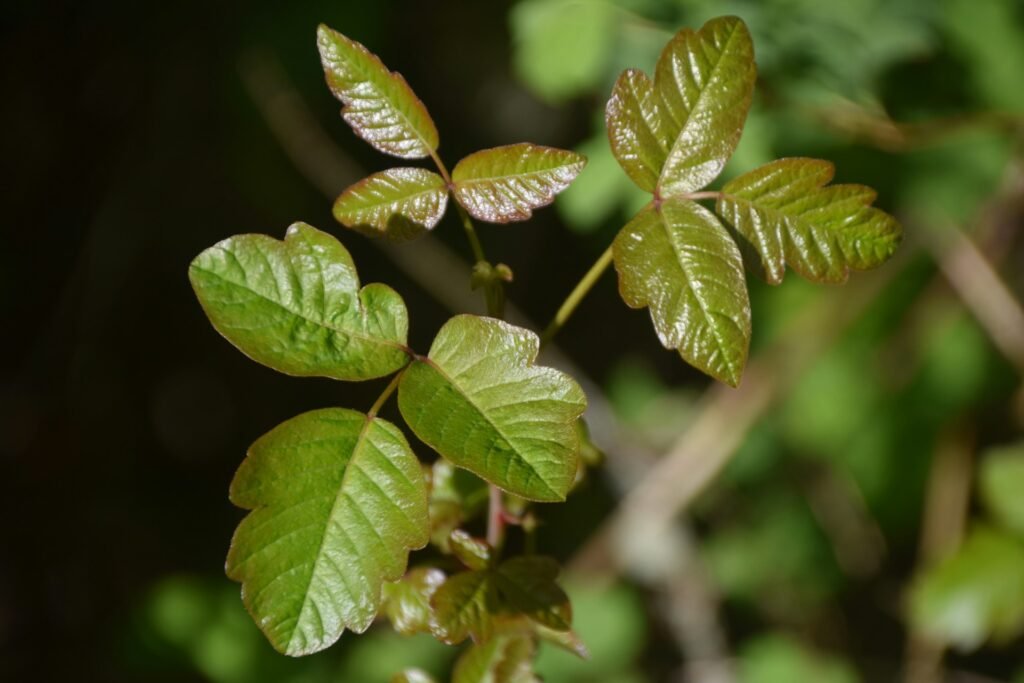
It contains that unmistakable toxic oil, urushiol, that is characterized by its ability to cause severe itchiness, rashes, redness, and swelling when touched and anaphylactic shock-like symptoms when consumed. The reaction is the same for humans and animals alike, so it’s best to keep your furry friends away from it, too!
Poison Sumac
Toxicodendron vernix
Poison Sumac is mainly found in the wetter areas of the great North American wilderness and rears its ugly head around wetlands, marshes, and rivers. While the rest of the members of the plant family are fairly harmless, a simple brush against a Poison Sumac leaf can make you feel itchy and sore for weeks!
The leaves of Poison Sumac grow in pairs down a long reddish stem and have a significant waxy appearance that separates them from their non-toxic counterparts.
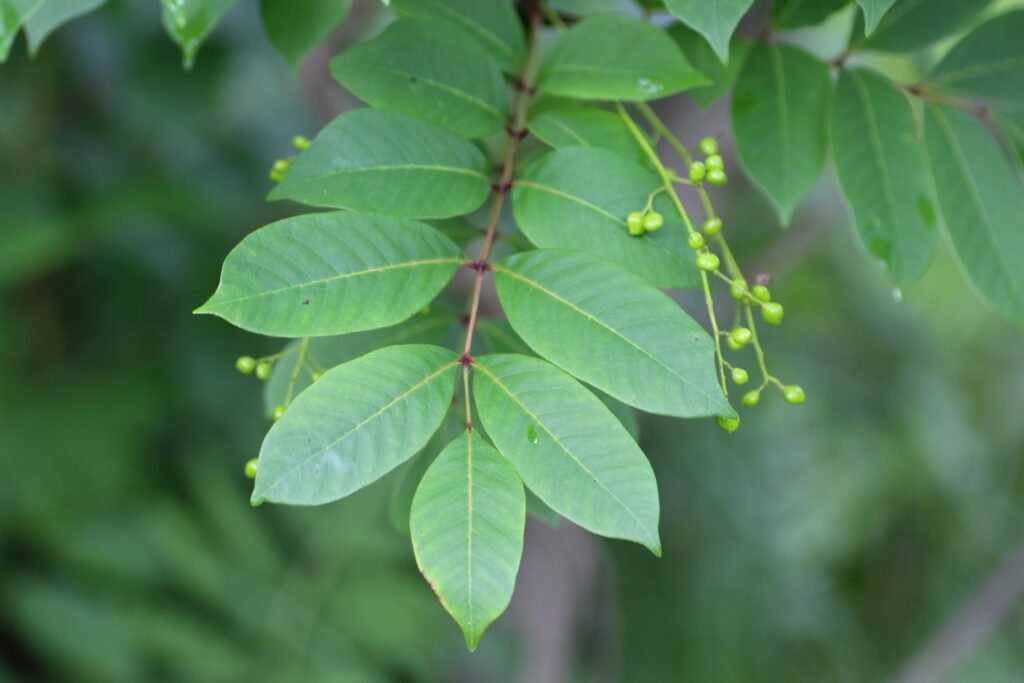
Like most sumacs, Poison Sumac also sprouts its own berries, but these don’t hold that appetizing bright red appearance but are small, solid, and pale white or green.
It’s classified as one of the most toxic plants in North America and contains the same noxious oil as Poison Ivy and Poison Oak. Urushiol may not be fatal with skin exposure but can require immediate attention to avoid giving yourself infections or spreading your rash. Essentially, all reactions to urushiol are similar and are only a real threat if the substance is consumed.
Giant Hogweed
Heracleum mantegazzianum
In the case of Giant Hogweed, stopping to smell the flowers is not a good idea at all! These towering behemoths are found scattered around North America and with a rather formidable appearance, are hard to miss!
They can grow up to 15 feet tall and have large, serrated leaves. The stem is thick, with purple blotching and coarse white hairs. Its most notable feature is the stunning flower clusters it grows.
The dainty white flowers grow in umbrella-like groups spanning over 2 feet wide. But we promise you, the scent is not worth touching this plant.
Giant Hogweed is toxic from its flowers down to the sap and causes severe allergic reactions in people! They create painful, itchy rashes that can spread across your skin and sometimes even form blisters. The toxins in Giant Hogweed sap are notorious for causing photosensitivity, which no amount of sunscreen can protect you from!
Jimson Weed
Datura stramonium
Jimson Weed is often a silent danger. Unlike the above-mentioned plants, where you’ll need direct contact with them to experience symptoms, Jimson Weed can be toxic just by breathing too close to it.
This plant is relatively tall, reaching heights of up to 5 feet and branches outward. It has beautiful trumpet-shaped flowers in white, yellow, and purple, with coarse, toothy leaves. Don’t be fooled by its good looks, though. The smell is ripe and unpleasant.

Jimson weed contains some powerful toxins known as alkaloids, which carry hallucinogenic properties. Exposure to these, either through eating or inhaling them, can cause some unpredictable behaviors and delirium. And while it might seem funny at first to watch your campmate complain about purple dragons, we can assure you that exposure to Jimson Weed is incredibly dangerous and sometimes even fatal.
Monkshood
Aconitum spp.
Monkshood is one of the most toxic plants found in nature across the globe. It has an affinity for growing in beautiful mountainous regions, and is often come across by hikers and outdoor adventurers.
The plant got its name from the hood-like shape of its flowers, which come in shades of blue, purple, and white. The flowers grow on tall spikes, peaking out of oddly-shaped leaves that resemble human hands.
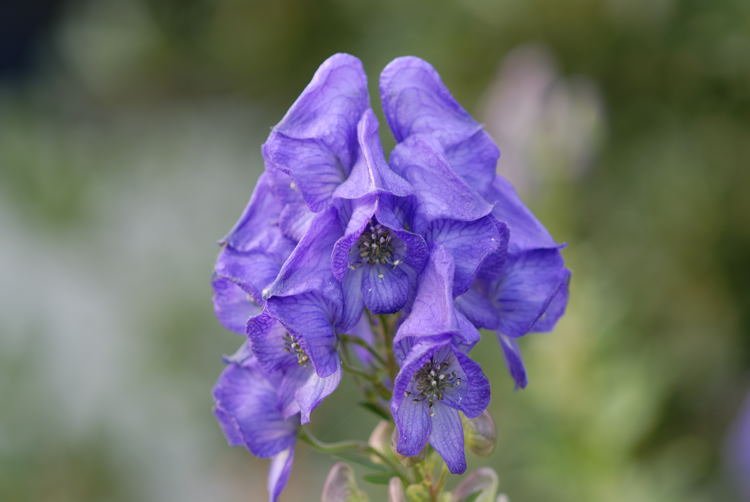
All parts of the Monkshood plant contain highly toxic substances known as aconitine alkaloids. Unlike other plants that may cause an upset stomach or a rash, these toxins directly attack the heart and nervous system. A bad encounter with Monkshood won’t just end you in the hospital. It could end up signing your obituary.
Deadly Nightshade
Atropa belladonna
Deadly Nightshade is a world-known poison that was the undoing of Shakespeare’s most infamous couple, Romeo and Juliet. It’s featured in many movies and books throughout history and is probably the most infamous toxic plant on our list!
If you’re not plant-savvy, you might just mistake those shiny black berries for a blueberry and pull a Katniss Everdeen. If you know what we mean. These berries are one of Deadly Nightshade’s defining characteristics, alongside purple bell-shaped flowers.
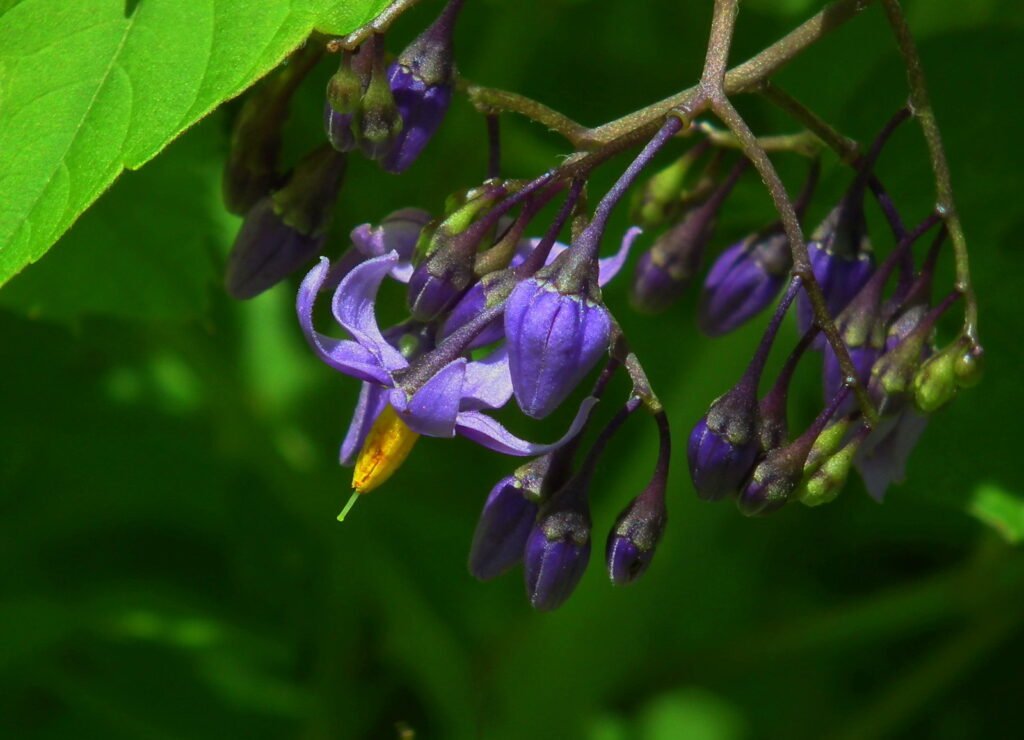
The plant looks harmless, but that’s made it a notorious poison throughout history.
Every single part of Deadly Nightshade contains atropine, scopolamine, and hyoscyamine, among other toxins. These alkaloids can cause hallucinations, heart problems, and stomach problems even when eaten in small doses. While most animals know to avoid the plants, small children and non-fussy pets have been known to grab and eat the berries when not properly supervised.
Water Hemlock
Cicuta spp.
Water Hemlock usually grows in wetlands, marshes, and alongside rivers but has spread its reach throughout North America. This plant, while beautiful to look at, is extremely toxic! Thanks to its similar appearance to wild carrots or parsnips, it’s easy to mistake Water Hemlock for something non-toxic, which is why you must be so cautious!
They grow to about 5 feet tall and have small pale flowers in umbrella-like clusters.
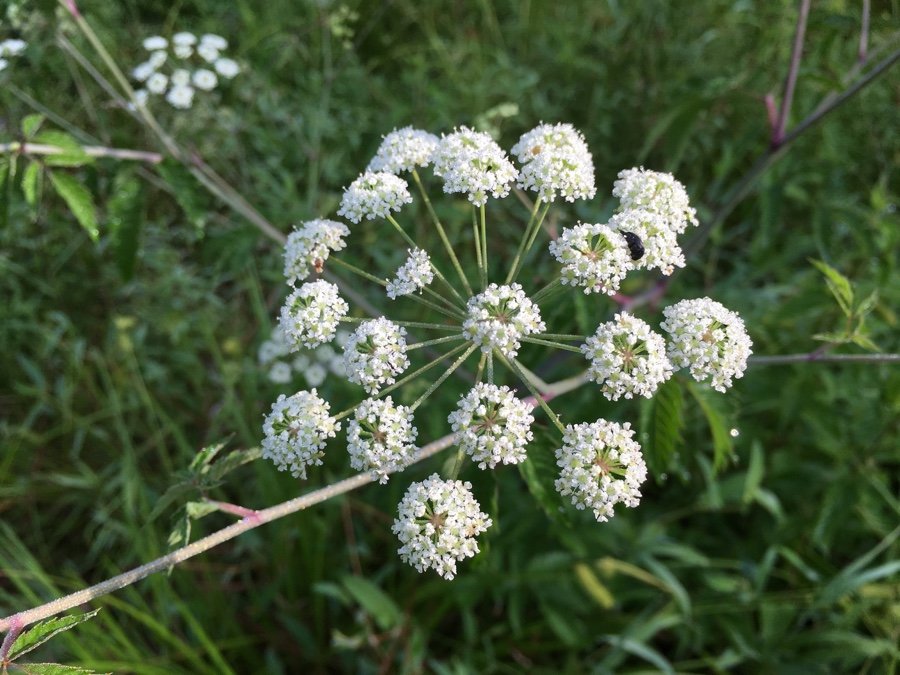
They grow plenty of leaves and have sturdy stems covered in purple blotches. Think of Giant Hogweed and make it smaller.
While most campers aren’t at risk of eating Water Hemlock, choosing instead to tuck into their Nature Valley Bars, there is still a chance of exposure. Every part of Water Hemlock contains a substance called cicutoxin, including the sap. Because Water Hemlock is known for growing in wet areas, it’s not uncommon for cicutoxin to contaminate nearby water.
Cicutoxin, similar to the alkaloids found in Monkshood and Nightshade, is known for causing heart, lung, and neurological symptoms! Your stomach may start to hurt, and you’ll feel dizzy and confused before experiencing shortness of breath and a rapid heartbeat. If left untreated, Water Hemlock’s symptoms can be fatal!
Minimizing Exposure To Toxic Plants
Luckily for you, adapting your habits to minimize exposure to deadly plants is easy!
- Stay on the marked trails and within designated areas.
- Supervise your children and pets at all times!
- Do not drink water that has not been filtered.
- Do not eat anything that you do not recognize!
- Keep your hands as clean as possible.
- Don’t stop to sniff the flowers; they can still poison you through inhalation.
- Learn how to recognize common toxic plants in your area.
First Aid and Treatment
We can’t reiterate enough how important keeping a first aid kit is when you go camping. Regardless of whether you’re a careful camper, nature is unpredictable, and you’ll always need to be as prepared as you can be.
But, most standard First Aid Kits don’t come with the types of treatments you may need for treating toxic plant exposure. In that case, here’s some things you’ll need:
Disposable Gloves – To avoid spreading the toxin to other areas of the body. You don’t want to touch the exposed area and risk the sap, thorns, or fibers getting on your hands and transferring to wherever you touch next.
Cleansing Wipes – To prevent infection and get rid of residue. Some plant sap can’t be removed with normal soap. Most medical-grade cleansing wipes have incredible capabilities, and could even get rid of the old oil stain on your grandmother’s couch!
Instant Cold Compress – To alleviate pain and help soothe exposed areas. Medpride Instant Cold Packs are single-use packs that don’t require any refrigeration or freezing, instead using a chemical compound to create an instant cooling effect that’ll do in a pinch.
Antihistamines – A simple over-the-counter antihistamine is always a must. Reactions to plants like Poison Oak, Poison Ivy, and Poison Sumac can be boiled down to allergic reactions, in which case Antihistamines will help alleviate most of the effects.
Topical Hydrocortisone Cream – Hydrocortisone creams can help alleviate itchiness, redness, and inflammation where the plant has been directly exposed to the skin.
Can Pets be Affected by Toxic Plants?
Absolutely! People and their furry friends have surprising similarities, which means if your dog or cat ingests, inhales, or steps onto certain toxic plants, they’ll have similar bad reactions.
Learn more about camping with dogs in our post here.
Conclusion
So now you know that understanding and being able to identify toxic plants is a handy skill that any camper should have. You never know when you could have a close encounter with the plant Bundy! Be prepared, be aware, and make sure to do everything you can to minimize your exposure.

